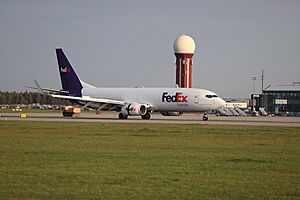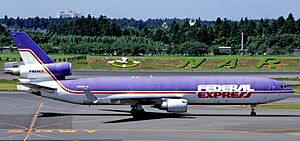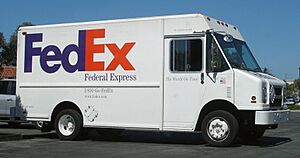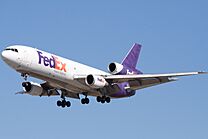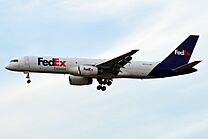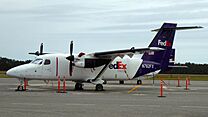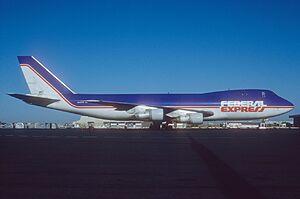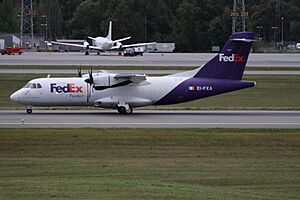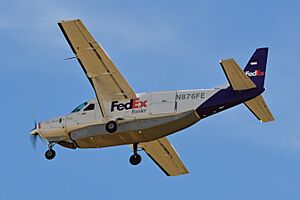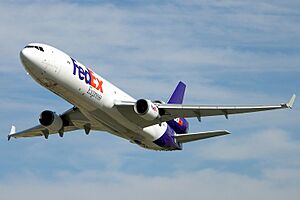FedEx Express facts for kids

A Boeing 767-300ER of FedEx Express
|
|
| Founded | June 18, 1971 |
|---|---|
| AOC # | FDEA140A |
| Hubs |
|
| Fleet size | 698 |
| Destinations | c. 375 |
| Parent company | FedEx Corporation |
| Headquarters | Memphis, Tennessee, United States |
| Key people | vacant (president & CEO) |
| Employees | 278,000+ (2022) |
FedEx Express is a huge American cargo airline. It is based in Memphis, Tennessee, in the United States. As of 2023, it is the world's largest cargo airline. This is true for both the number of planes it has and the amount of freight it carries.
FedEx Express is the main part of FedEx Corporation. It delivers packages and freight to over 375 places in more than 220 countries every day. It is also the biggest company for express transportation in the world.
The company's main global hub is at Memphis International Airport. In the United States, FedEx Express has a national hub at Indianapolis International Airport. There are also regional hubs in the U.S. at airports in Anchorage, Fort Worth, Greensboro, Miami, Newark, Oakland, and Ontario.
International hubs are located at airports in Cologne/Bonn, Dubai, Bengaluru, Delhi, Guangzhou, Liege, Milan, Mumbai, Osaka, Paris, Seoul, Shanghai, Singapore, Taipei, Tokyo, and Toronto.
Contents
How FedEx Express Started and Grew
The Beginning of a Big Idea
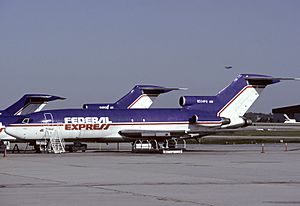
The idea for Federal Express came from Fred Smith in the mid-1960s. He was a student at Yale at the time. For a class, he wrote a paper saying that in modern times, speed was very important for delivering valuable items. He thought that air transport was the only way to deliver things fast enough. However, he believed the air cargo system in the U.S. was too slow and had too many rules.
Fred Smith suggested a new way of doing things. One company would be in charge of a package from when it was picked up until it was delivered. This company would have its own planes, sorting centers, and delivery vans. To make sure every package was sorted correctly, all items would fly to a central hub. From there, the whole operation would be managed.
Smith started Federal Express Corporation in 1971. He used money he inherited and also got money from investors. The company first started in Little Rock, Arkansas. But because of a lack of support from the local airport, Smith moved the company to Memphis, Tennessee, in 1973.

The company began its overnight delivery service on April 17, 1973. They used fourteen Dassault Falcon 20 planes to connect twenty-five cities in the United States. On that first night, 186 packages were delivered. Federal Express advertised itself as "the freight service company with 550-mile-per-hour delivery trucks."
At first, the company had money problems. Fred Smith even won $27,000 playing blackjack in Las Vegas to help pay the staff one week! He later raised a lot more money from investors. Federal Express became the most highly funded new company in U.S. history at that time.
In 1975, Federal Express put out its first drop boxes. This made it easier for customers to send packages. By 1976, the company was making a profit, handling about 19,000 packages every day. The company became famous for its ads, especially one with a fast-talking actor saying, "When it absolutely, positively has to be there overnight."
Growing Very Quickly
In 1977, new laws allowed all-cargo airlines to fly more freely. This helped Federal Express buy its first large planes, seven Boeing 727-100s. In 1978, the company became public, meaning its shares could be bought and sold on the stock market.
The next year, Federal Express was the first shipping company to use computers to manage packages. They launched "COSMOS," a system that tracked people, packages, vehicles, and even weather in real time. In 1980, they added "DADS" to help customers schedule pickups.
By 1981, Federal Express started flying to Canada. They also officially opened their main "Superhub" at the Memphis International Airport. In 1983, the company's sales reached over $1 billion for the first time.
In the 1970s, FedEx created tracking numbers to follow packages. This information was later made available to the public. In 1986, the company introduced the "SuperTracker," a hand-held scanner that allowed people to track their packages for the first time.
Federal Express kept growing fast in the late 1980s. They opened new hubs at Newark Liberty International Airport in 1986, and at Indianapolis International Airport and Oakland International Airport in 1988. In 1989, they bought Flying Tiger Line to expand their international service. This led to a new hub at Ted Stevens Anchorage International Airport. As more international shipments happened, Federal Express created a system to clear customs faster while cargo was still flying.
The FedEx Name and Beyond
In 1994, Federal Express changed its name to "FedEx" for marketing. This was a nickname people had used for years. That same year, FedEx launched fedex.com. It was the first shipping website to offer online package tracking. This allowed customers to do business over the internet.
In 1995, the company started services to China. They opened an Asia and Pacific hub in Subic Bay International Airport in the Philippines. In 1997, FedEx opened a hub at Fort Worth Alliance Airport. In 1999, a European hub opened at Charles de Gaulle Airport in France.
In 1998, FedEx joined with another company and became FDX Corporation. In 2000, FDX changed its name to FedEx Corporation. The original "Federal Express" cargo airline then changed its name to "FedEx Express." This helped people know it was the express shipping part of the bigger FedEx company.
In 2001, FedEx Express signed a big contract to carry all Express Mail and Priority Mail for the United States Postal Service. This contract also allowed FedEx to place drop boxes at every USPS post office. This partnership has continued for many years.
In 2006, FedEx Express bought a British company called ANC Holdings Limited. This added 35 sorting places to the FedEx network. In 2007, ANC became FedEx UK. FedEx Express also bought a company in Hungary to grow in Eastern Europe.
Tough Economic Times
The Great Recession in the late 2000s was hard on FedEx Express. Many companies shipped less or chose cheaper ways to send things. FedEx Express had to reduce its number of planes. They retired some of their oldest planes, like the McDonnell Douglas DC-10 and the Airbus A310. FedEx also had to reduce staff and work hours at some of its hubs.
In February 2009, FedEx Express closed a hub for the first time. This was its Asian-Pacific hub in the Philippines. The work from this hub moved to Guangzhou Baiyun International Airport in China.
On June 2, 2009, FedEx opened a new hub building at Piedmont Triad International Airport in Greensboro, North Carolina. This hub had been planned for many years.
On October 27, 2010, FedEx opened its Central and Eastern European hub at Cologne Bonn Airport. This hub has a system that can sort up to 18,000 packages every hour. The roof of the hub has FedEx's largest solar power system.
Recent Growth
On November 6, 2019, FedEx Express announced it was returning to the Philippines for its Asia–Pacific hub. They planned to expand operations in Clark, Pampanga. On October 6, 2020, FedEx celebrated 36 years of operations with a new gateway in Clark. The company built a large facility there, which opened in July 2021.
FedEx Express Aircraft Fleet
Current Aircraft Used
As of June 2025, FedEx Express uses these aircraft:
| Aircraft | In service |
Orders | Notes |
|---|---|---|---|
| Airbus A300-600RF | 64 | — | Includes the last Airbus A300 ever built. Older planes are being replaced by Boeing 767-300F. FedEx is the largest operator of this type. |
| Boeing 757-200SF | 87 | — | FedEx is the largest operator of this type. |
| Boeing 767-300F | 146 | 6 | Deliveries are happening until 2025. These planes are replacing older Airbus A300-600RF and MD-11F aircraft. FedEx is the largest operator. |
| Boeing 777F | 59 | 8 | Deliveries are happening until 2027. These planes are replacing MD-11F aircraft. FedEx was the first customer in America for this plane and is the largest operator. |
| McDonnell Douglas MD-11F | 25 | — | FedEx is the largest operator. These planes are planned to be retired by 2032. They are being replaced by Boeing 767-300F and Boeing 777F. |
| Total | 381 | 14 | |
| FedEx Feeder planes (contracted) | |||
| ATR 42-300F | 15 | — | |
| ATR 72-200F | 19 | — | |
| ATR 72-600F | 24 | 16 | FedEx was the first customer for this plane. Deliveries started in 2020. |
| Cessna 208B Super Cargomaster | 231 | — | FedEx is the largest operator. |
| Cessna 408 SkyCourier | 28 | 22 | FedEx was the first customer for this plane. Deliveries started in May 2022. |
| Total | 317 | 38 | |
Note: "F" means freighter aircraft. "SF" means special freighter aircraft, which are passenger planes changed to carry cargo.
FedEx Express has one of the world's largest cargo air fleets, with over 650 aircraft. It is the biggest user of several plane types, including the Airbus A300, ATR 42, Cessna 208, DC-10/MD-10, and the MD-11.
In 2007, FedEx decided to buy 90 Boeing 757-200SFs. Since these planes were no longer made, FedEx bought used ones from other airlines. The last Boeing 727 was retired on June 21, 2013, after 35 years of service with FedEx.
FedEx Express was supposed to be the first airline to use the Airbus A380 freighter. However, because of delays, FedEx canceled these orders. Instead, they ordered 15 Boeing 777Fs. In 2011, FedEx ordered 27 Boeing 767-300Fs to replace its MD-10s. The first Boeing 767-300F was delivered on September 4, 2013.
FedEx Express is a big part of the Civil Reserve Air Fleet in the United States. This means they lend their planes to the U.S. government if needed for emergencies.
The very first Dassault Falcon 20C plane delivered to FedEx is now on display. You can see it at the Steven F. Udvar-Hazy Center of the National Air and Space Museum.
Past Aircraft Used
| Aircraft | Total | Started Using | Stopped Using | Replaced by | Notes |
|---|---|---|---|---|---|
| Airbus A310-200F | 49 | 1994 | 2016 | Boeing 757-200SF | Includes the first A310 prototype. |
| Airbus A310-300F | 21 | 2000 | 2020 | Boeing 767-300ERF | Last flight was January 4, 2020. |
| Boeing 727-100F | 75 | 1977 | 2013 | Boeing 757-200SF | Last flight was June 21, 2013. |
| Boeing 727-200F | |||||
| Boeing 737-200C | 5 | 1978 | 1981 | None | |
| Boeing 747-100SF | 11 | 1989 | 1996 | McDonnell Douglas MD-11F | Acquired when Flying Tiger Line joined FedEx. |
| Boeing 747-200F | 11 | ||||
| Dassault Falcon 20 | 33 | 1973 | 1985 | Boeing 727 | |
| Douglas DC-8-73CF | 6 | 1989 | 1991 | None | Acquired when Flying Tiger Line joined FedEx. |
| McDonnell Douglas DC-10-10F | 25 | 1980 | 2021 | Boeing 767-300F | |
| McDonnell Douglas DC-10-30F | 6 | 1980 | 2022 | Boeing 767-300F McDonnell Douglas MD-11 |
|
| McDonnell Douglas MD-10-10F | 64 | 1980 | 2021 | Boeing 767-300F | |
| McDonnell Douglas MD-10-30F | 18 | 1980 | 2023 | Boeing 767-300F |
FedEx Feeder Planes
FedEx Feeder is the name for smaller, propeller-driven planes. These planes bring packages to and from airports that are served by larger jet aircraft.
In the United States, FedEx Express works with other companies for FedEx Feeder flights. These companies rent planes from FedEx and fly routes given to them. The company is in charge of the crew and maintaining the aircraft. FedEx pays them for this work. Since FedEx owns the planes, they can only be used for FedEx Feeder routes.
Outside the United States, companies flying FedEx Feeder routes sometimes use their own planes. These planes might not have the FedEx Feeder colors. The companies might also carry cargo for other businesses along with FedEx cargo.
Some companies that fly for FedEx Feeder:
- ASL Airlines Ireland (biggest partner in Europe)
- Airwork
- Baron Aviation Services
- Cargojet
- Carson Air (flies in Western Canada)
- Corporate Air
- CSA Air
- Empire Airlines
- IFL Group
- Merlin Airways
- Morningstar Air Express (also flies main FedEx service in Canada)
- Mountain Air Cargo
- Solinair
- Swiftair
- West Air Inc.
- Wiggins Airways
Helping the Environment
Greener Delivery Trucks
In 2003, FedEx Express started using hybrid electric/diesel trucks. These trucks use less fuel and produce less pollution. By June 2009, 170 of these trucks were in use. Most were in the United States, but some were in Tokyo, Toronto, and Turin.
FedEx said that the hybrid trucks reduced soot by 96% and other harmful emissions by 65%. They also used over 50% less fuel.
In 2009, FedEx Express worked with Iveco to test new hybrid electric/diesel vans in Italy. These vans were expected to use 26.5% less fuel and reduce carbon dioxide emissions. FedEx also partnered with Freightliner and Eaton Corporation to change 92 delivery trucks into hybrids. These trucks were used in California.
In November 2009, FedEx Express bought 51 gasoline-electric hybrid vehicles. These were used in The Bronx, New York City. The Bronx became FedEx's first station to use only hybrid vehicles.
Modernizing Aircraft
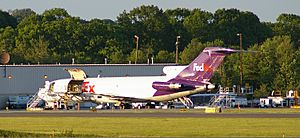
FedEx Express is working to replace its older planes with newer, more fuel-efficient ones. For example, the Boeing 727 planes were replaced by the Boeing 757 in 2013. The company says the 757s use less fuel. Some of the old Boeing 727s were given to flight schools.
Since 2013, FedEx has been buying new 767 and 777 cargo planes. The 777 planes have replaced the older MD-11s on long international flights. This allowed the MD-11s to fly shorter routes. This change also meant that the old DC-10 planes could be retired by 2023. The new planes also allowed the older, smaller Airbus A310 cargo planes to be retired by 2020. As more new planes arrive by 2025, FedEx plans to retire the remaining MD-11 aircraft and some Airbus A300 cargo planes.
Safety and Incidents
Over the years, FedEx Express has had some incidents with its main fleet. This table lists some of the more notable events.
| Flight number |
Date | Aircraft type | Details |
|---|---|---|---|
| 705 | 1994-04-07 | McDonnell Douglas DC-10-30 | A pilot tried to take over the plane and crash it. The crew fought back and managed to land the plane safely. The aircraft was repaired and used again. |
| 1406 | 1996-09-05 | McDonnell Douglas DC-10-10 | The plane had a fire while flying and made an emergency landing. After landing, the fire destroyed the aircraft. |
| 14 | 1997-07-31 | McDonnell Douglas MD-11 | The plane had a very rough landing, causing it to flip over. The crew escaped safely before the plane was destroyed by fire. |
| 87 | 1999-10-17 | McDonnell Douglas MD-11 | Upon landing, the plane went past the end of the runway and into the bay. It was completely damaged. |
| 1478 | 2002-07-26 | Boeing 727-232 | The plane hit a tree and crashed before reaching the runway. The aircraft was destroyed by fire. |
| 647 | 2003-12-18 | McDonnell Douglas MD-10-10 | After landing, the right landing gear broke, causing the plane to go off the runway. The aircraft was destroyed by fire. |
| 630 | 2006-07-28 | McDonnell Douglas MD-10-10 | After landing, the left landing gear broke. This caused damage to the plane, and it was taken out of service. |
| 80 | 2009-03-23 | McDonnell Douglas MD-11 | The plane had a difficult landing in windy conditions and crashed. Sadly, the two crew members on board did not survive. |
| 910 | 2016-10-28 | McDonnell Douglas MD-10-10 | Upon landing, the left engine caught fire. The landing gear then broke, and the aircraft was taken out of service. |
Protecting Planes from Missiles
In 2003, FedEx Express worked with the Department of Homeland Security to create an anti-missile system called the Northrop Grumman Guardian. This system is designed to protect planes from missile attacks. FedEx provided an MD-11 and a Boeing 747 for testing this system.
FedEx Express was the first airline to use the Guardian system on a commercial flight in September 2006. By December 2007, nine of their planes had the system for more testing. Because the program was successful, the U.S. Congress asked for it to be used on passenger planes too.
FedEx Sorting Centers
North and South America
 United States
United States
- Anchorage, AK – International transfer hub
- Fort Worth, TX – Southwest U.S. hub
- Greensboro, NC – Mid-Atlantic U.S. hub
- Indianapolis, IN – National U.S. hub
- Miami, FL – Latin America hub
- Memphis, TN – Global "Superhub" (main hub)
- Newark, NJ – East Coast U.S. hub
- Oakland, CA – West Coast U.S. hub
Asia
Europe
 France
France
 Belgium
Belgium
- Liege – Hub for flights within Europe
 Germany
Germany
- Cologne/Bonn
 United Kingdom
United Kingdom
See also
 In Spanish: FedEx Express para niños
In Spanish: FedEx Express para niños
- Air transportation in the United States
- Aviation
- DHL Aviation
- FedEx Corporation
- List of airlines of the United States
- List of airports in the United States
- TNT Airways
- Transportation in the United States
- UPS Airlines
- USPS


